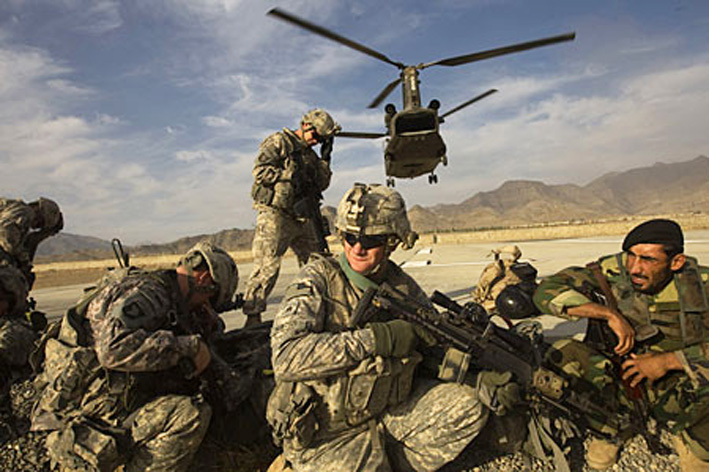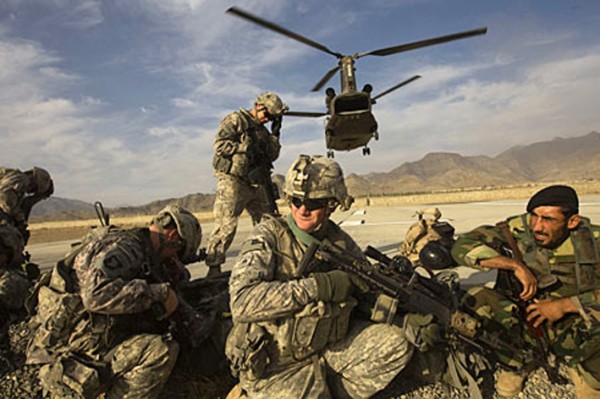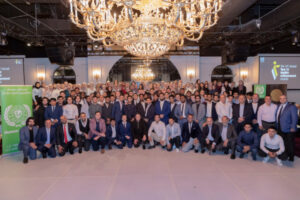

Syria will have to wait. The next stop in the Pentagon-coined “long war” is bound to be Pakistan. True, a war is already on in what the Barack Obama administration named AfPak. But crunch time in Pak itself looms closer and closer. Call it the “no bomb left behind” campaign.
Al-Qaeda is a thing of the past; after all, al-Qaeda assets such as Abdelhakim Belhaj are now running Tripoli. The new Washington-manufactured mega-bogeyman is now the Haqqani network.
A relentless, Haqqani-targeted manufacture of consensus industry is already on overdrive, via a constellation of the usual neo-conservative suspects, assorted Republican warmongers, “Pentagon officials” and industrial-military complex shills in corporate media.
The Haqqani network, a force of 15,000 to 20,000 Pashtun fighters led by former anti-Soviet mujahideen figure Jalalludin Haqqani, is a key component of the Afghan insurgency from its bases in Pakistan’s North Waziristan tribal area.
For Admiral Mike Mullen, chairman of the US Joint Chiefs of Staff, the Haqqani network “acts as a veritable arm of Pakistan’s Inter-Services Intelligence [ISI] agency”. It took Mullen no less than 10 years since Washington’s bombing of Afghanistan to figure this out. Somebody ought to give him a Nobel Peace Prize.
According to the US government narrative, it was the ISI that gave the go-ahead for the Haqqani network to attack the US Embassy in Kabul on September 13.
Pentagon head Leon Panetta has gone on record saying that in response, Washington might go unilateral. This means that the vast numbers of Pashtun farmers, including women and children, who have already been decimated for months by US drone attacks on the tribal areas should be considered as extras in a humanitarian operation.
The Pentagon’s “long war”, also known as the “war on terror”, may have cost the Pakistani economy up to a staggering $100 billion – and over 30,000 casualties, a large number of them civilians. Under “no bomb left behind”, expect “collateral damage” to keep piling up.
When in doubt, read the book
Predictably, Pakistani army chief General Ashfaq Parvez Kiani – incidentally, a Pentagon darling – denies the ISI is in bed with the Haqqanis. Well, they are. But even more salacious is the current Pakistani official spin – that because the US has failed so miserably in Af, now they are trying to blame Pak for the whole mess.
Looks like Mullen at least has been catching up with the late Syed Saleem Shahzad’s essential book on AfPak, Inside al-Qaeda and the Taliban: Beyond Bin Laden and 9/11. In the book, Saleem, who as Asia Times Online’s Pakistan bureau chief, details how the legendary – and vain – Jalalludin Haqqani (who still loves to dye his hair) never ceased to be a leading Taliban warlord; and how the ISI never stopped telling him that their offensives against himself, his son and his network were only a show.
The Haqqanis may be based in North Waziristan, but they run a great deal of the show in Paktia, Paktika and Khost on the other side of the border. Wily Jalalludin has pledged total allegiance to Taliban leader Mullah Omar – who everybody knows is holed up in Quetta, in Pakistan’s Balochistan province, but remains mysteriously invisible even to the best US eyes in the sky.
To believe that the ISI would simply get rid of the Haqqanis, or disable their North Waziristan bases so they wouldn’t be able to attack US and North Atlantic Treaty Organization (NATO) forces in Afghanistan anymore, is pure wishful thinking. The Pakistani military has a major dog in the Afghan fight. And the name of the dog is Taliban – which they “invented” in the early 1990s.
Moreover, the Haqqanis can always be counted on as a sort of reserve army to fight the possibility of increasing Indian influence in Afghanistan.
When Pakistani Foreign Minister Hina Rabbani Khar says the US “cannot afford to alienate Pakistan”, she’s totally right. If that happens, the historic Taliban would turbo charge their already constant string of lethal attacks inside Afghanistan. The Tehrik-e-Taliban Pakistan (Pakistan Taliban – TTP) would turbo charge cross-border attacks, from Kunar and Nuristan in Afghanistan into Dir and Bajaur in Pakistan. And hardcore military factions in Pakistan would be even more motivated to get rid of the civilian government altogether.
Because Washington to some extent trains and equips Islamabad’s military, and the US Central Intelligence Agency (CIA) is so very cozy with the ISI, some may think Washington “owns” Islamabad.
It does – but up to a point. Somebody should convene a seminar in Washington to explain that the Pakistani army has a very different agenda from the ISI, while the ISI is crammed with secret rogue cells; it’s one of those cells that may have murdered Saleem Shahzad.
The Pakistani military is trying to make sure the “historic” Taliban led by Mullah Omar, as well as the Hizb-e Islami of Gulbuddin Hekmatyar, lose much of their influence in Afghanistan. But at the same time, these hardcore ISI cells want to keep supporting the Haqqani network as a means to keep any future Afghan government on its toes.
Time for Beijing to collect
The going will get really tough if – when – the Pentagon/CIA/White House consortium decides that US Special Forces will violate Pakistani sovereignty by helicopter, a la the Abbottabad raid that killed Osama bin Laden, and go for the Haqqanis and thus risk a direct clash with the Pakistani army. Prime Minister Yousuf Raza Gilani has already called an emergency meeting exactly to analyze this distinct possibility.
If that happens, Islamabad will certainly pull out all stops to dismantle Washington’s critical logistics supply network from the southern port city of Karachi to the Khyber Pass, severely disrupting the flow of NATO supplies to Afghanistan. It will destroy any possibility of intelligence-sharing and cooperation in counter-terrorism/counter-intelligence. Even al-Qaeda will have a new lease of life all across Pakistan – and not only in the tribal areas.
Not to mention that Pakistan has an army of 610,000 – with about 500,000 reserves. Considering that only 15,000 to 20,000 Taliban have been able to run rings around US/NATO troops in Afghanistan for years, the math spells out only one option for Washington: disaster.
Pakistan is one of China’s major geopolitical assets. There’s no question Beijing has already run plenty of calculations on how Washington’s strategic folly – or irrepressible desire to launch a “kinetic” whatever operation – can only result in total alienation of Pakistan.
Public Security Minister Meng Jianzhu – China’s top security official – was in Rawalpindi on Monday. Significantly, Interior Minister Rehman Malik stressed, “China is always there for us in the most difficult moments.” Meng for his part said they discussed ways to “contribute to national security and regional stability”.
Also this week, the Pakistani army engaged in joint exercises in the Punjab with forces from “Pakistan’s special friend” Saudi Arabia. With special friends like Beijing and Riyadh to compensate for lost military equipment or revenue, no wonder Pakistan’s generals are not exactly mired in desperation.
Yet Washington is desperate, feeling the urge to do something. So what to expect from now on?
Expect a festival of MQ-9 Reapers droning North Waziristan to death. What US President Barack Obama calls a tool of “unique capabilities”, for Pashtun farmers is a weapon of terror.
Expect strike after strike conducted out of a control room in Nellis air force base in Nevada.
Expect an array of strategic missile bombings with spectacular collateral damage.
Expect more Joint Special Operations Command-ordered special operations forces “kill/capture” raids.
Expect a new, humongous Joint Prioritized Effects List, just like in Afghanistan; no names, just a list of mobile or satellite phone numbers. If your mobile gets on the list by mistake, you’ll be snuffed the Hellfire way.
Expect deadly, eternal Pashtun vengeance against Americans to be as irreversible as death and taxes.
And most of all, expect a low intensity war to turn volcanic anytime.



